
FCBarcelona
.pdf
Triangle passing 15x15 yard area One in a series of Dutch-inspired passing movements that are reflected in Barcelona’s midfield possession game in particular. Player 1 checks away and then back to the ball. Player 1 passes to player 2. Player 2 lays the ball off for player 1 to run onto and then spins off to the outside. Player 1 plays into the feet of player 3 and then moves ahead one cone. Player 3 lays the ball off for player 2 to run onto and then spins off and player 2 plays into his path before moving ahead one cone. Player three dribbles the ball to the start point for player 4 and the sequence repeats. This exercise builds speed, running off of the ball, communication and sharp one-touch play into a team. It also helps players become accustomed to playing together in a fast-paced pattern play environment.
©WORLD CLASS COACHING |
Page | 60 |
FC Barcelona – Style and Domination |
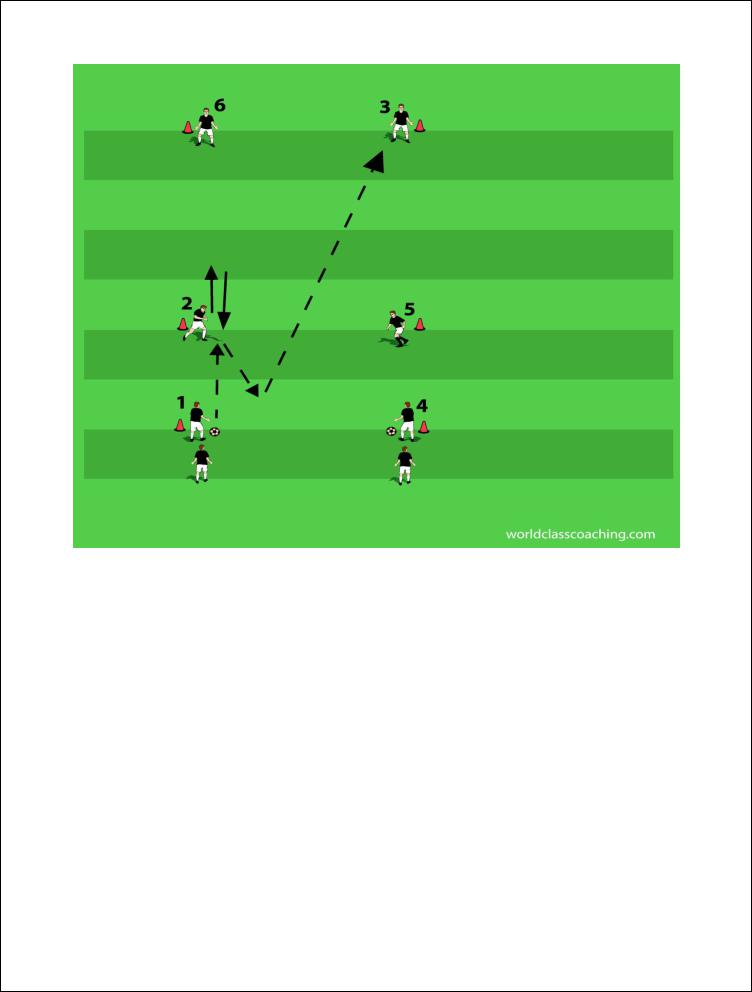
Rectangle pattern passing 15x25 yard area This exercise features check runs, penetration and lay-off and also long passing repetition, elements reflected in Barcelona’s short possession in the midfield before a precision penetrating pass. The variations also add some combination play after the long pass, requiring running off of and in support of the ball. Player 2 checks away and then back to the ball. Player 1 passes to player 2, who lays the ball off toward the inside of the grid for player 1. Player 1 then passes into the feet of player 3. Players 1 and 2 move up one cone in the sequence while player 3 dribbles the ball at speed back to the starting point. Meanwhile, the exercise is repeated on the other side of the grid. As the players become more comfortable, encourage them to play one-touch where possible and at speed throughout.
Variation:
•player 2 checks away and then back to the ball. Player 1 passes to player 2, who lays the ball off toward the inside of the grid for player 1. Player 1 then passes into the feet of player 3. Player 2 shows to the inside of player 3, who plays a 1-2 with player 2 before continuing back to the starting point. As with the base exercise, players move up one cone with each sequence, and they should play at speed and with minimal touches as they become more accustomed to the pattern. Finally, advanced teams can use the check run by the initiating player on one side as the passive defender for the 1-2 from the other side of the grid.
©WORLD CLASS COACHING |
Page | 61 |
FC Barcelona – Style and Domination |
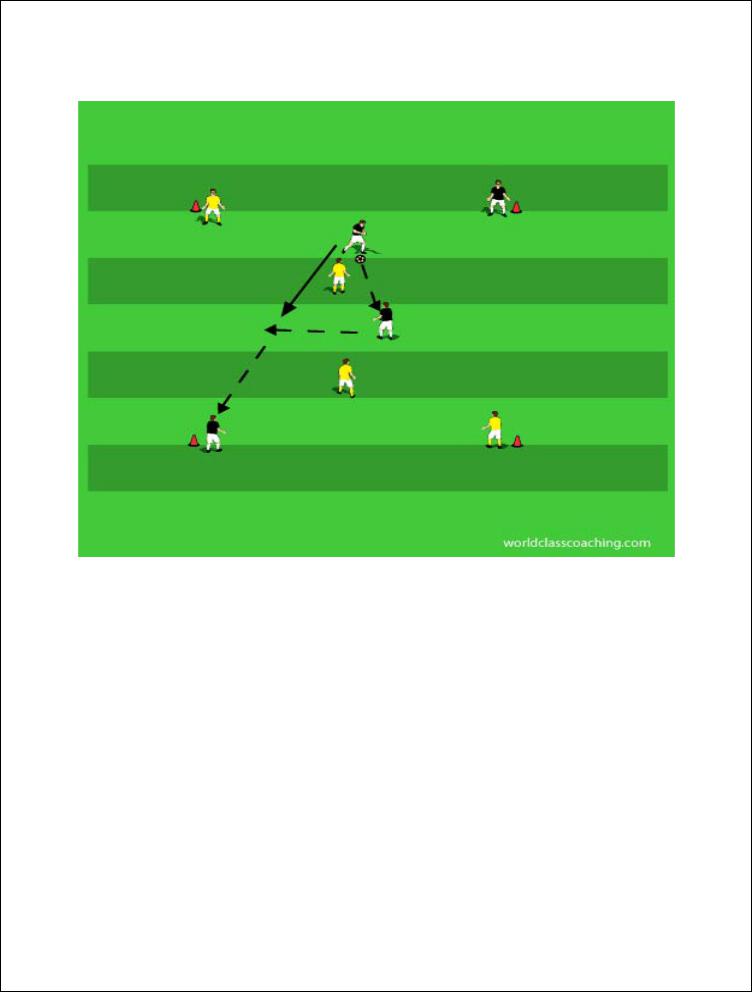
Possession
2v2+4 12x12 yard grids This is a dynamic possession game that includes opportunities for players to sharpen speed of play, combination play, vision, fitness and more. Play 2v2+4, with each team having a pair of diagonally-placed corner targets to play to. Players who pass into a target take that player’s spot, while the target quickly dribbles into the grid and works with the remaining teammate to try to get the ball to the other target. This is an outstanding environment for training on 1-2 combinations, as the numbers, speed and space all force players to step, think and play quickly.
©WORLD CLASS COACHING |
Page | 62 |
FC Barcelona – Style and Domination |
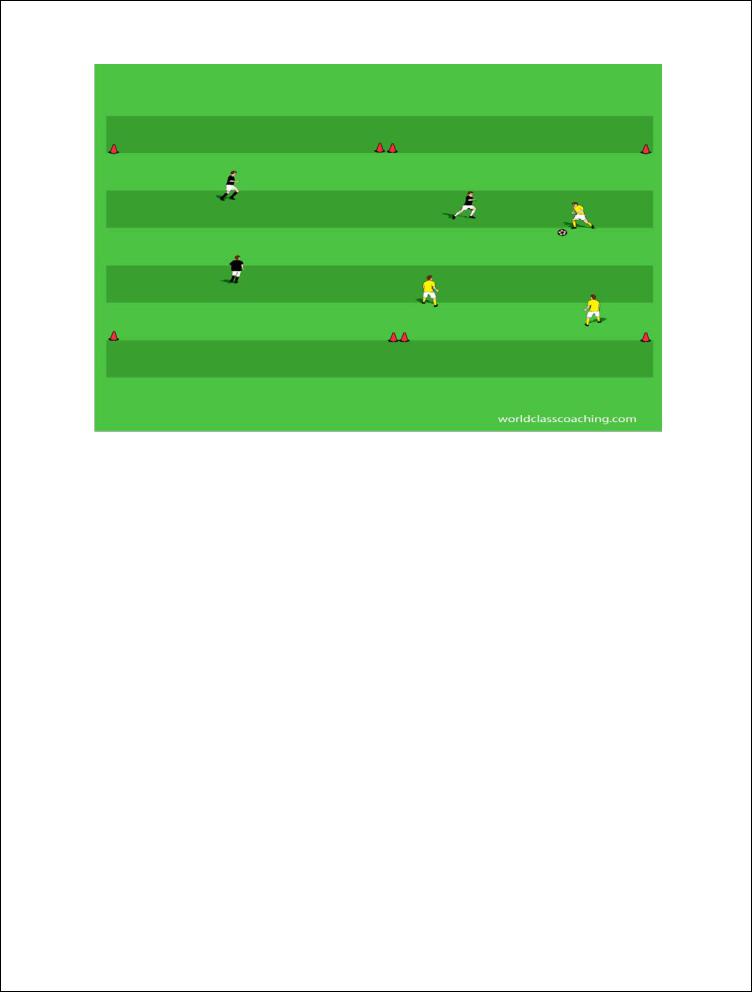
3 vs. 3 functioning as 3 vs. 1 back-to-back 15x15 yard grids Play 3 vs. 3 functioning as 3 vs. 1. Build two grids back-to-back and place teams of three in each grid (one team in vests). Demonstrate with one set of teams. Put a ball in one grid and explain that the team in the grid needs to try to keep the ball in possession as long as possible through dribbling and passing. The other team (in the adjacent grid) sends in one player to try to win the ball (if she wins it, she passes it back to her team in the other grid and the teams switch roles. The coach should keep a supply of balls outside the perimeter where the two grids join and every time the ball leaves the area, the coach plays a new ball into either grid to restart play.
Coach/observe:
•the teams will tend to stand close together in possession. Through a demonstration, show that players who are more spread out in the grid can make longer passes and more easily maintain possession.
•encourage players to work hard off of the ball to create angles where they can receive the ball.
•players should learn to anticipate the angle they will use to pass the ball and then use their first touch to prepare the ball in that direction.
•if one player is unable to win the ball as the defender, release a second player to enter the grid to help win the ball.
©WORLD CLASS COACHING |
Page | 63 |
FC Barcelona – Style and Domination |
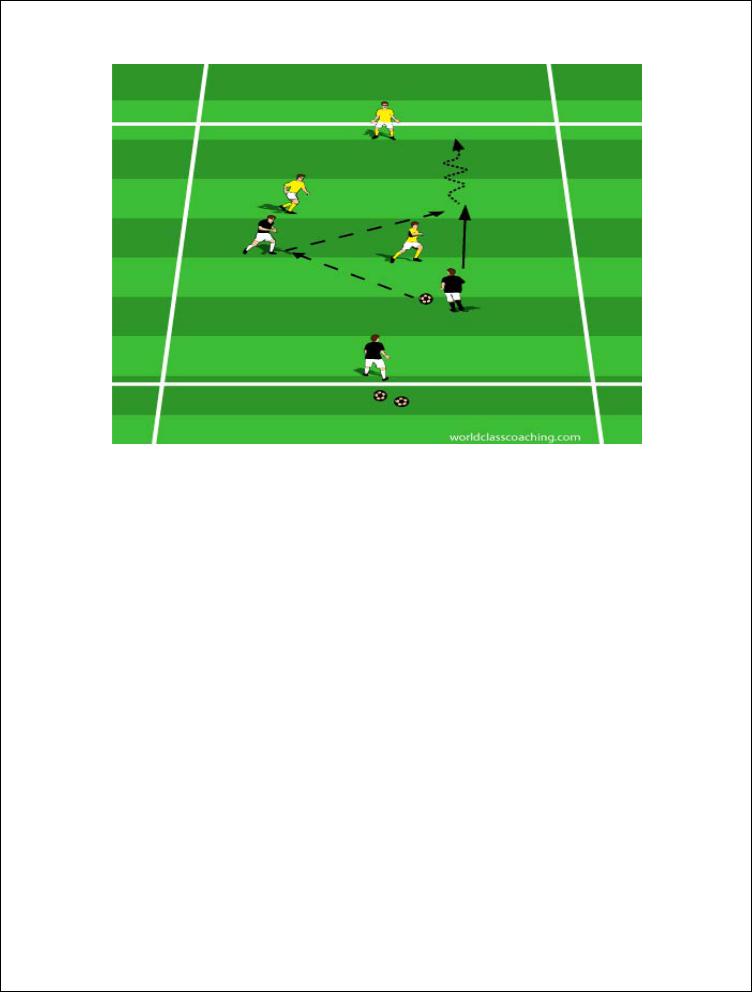
2v2 with end line bumpers 20x25 yard grids with cone or PUGG goals This environment is terrific for developing the role of support play and transition, both key elements in Barcelona’s possession. Play 2v2 games with a support player (‘bumper’) on each end for each team. The bumpers are limited to one-touch play and should be used to release pressure (on the defensive end line) and open up the game and create opportunities to goal (on the attacking end line). Bumpers can move back and forth along the end line but cannot be tackled and cannot enter the field of play. Bumpers restart play as well, and should have a ball supply ready. No throw-ins, corners, or goal kicks are played in this game, with the emphasis being on fast break attacking and transitional play on both sides of the ball. Play for 5 minutes and then rotate the bumpers.
Coach:
•encourage players to speed up their thinking and footwork when a bumper is about to be played. Given that the bumpers are limited to a single touch, it is mandatory that the team in possession (and the defenders, too) are active and reading and running off of the pass.
•as always, communication is critical. The active players will change roles, check in and out and generally have to read and interact with one-another to be successful.
Variation:
•bumpers are located at the sides of the grid.
©WORLD CLASS COACHING |
Page | 64 |
FC Barcelona – Style and Domination |

Transition strike (2) 12X15 yard grids Barcelona are clinical about pushing extra players into the attack. This setting, also used to teach counter-attacking, is ideal for teaching backs and midfielders the moment to join in the attack (both as second and third attackers), and for teaching strikers hold-up play as well.
Players are organized in groups of three. Play on fields divided into two 12X15 yard grids. Each team plays two defenders and one forward. The forward cannot leave the front grid and the backs can only go into the front grid if they play into the striker. No one is allowed to play goalkeeper in this exercise. Play for 10 minutes, rotating the attacking player in each grid. Then, institute a rule that the striker is limited to one touch and when one defender plays into the striker, the other must go forward in support of the attack (the player passing forward cannot go forward). This requirement gets all 3 players to think ahead and look for a third attacker in possession.
©WORLD CLASS COACHING |
Page | 65 |
FC Barcelona – Style and Domination |

3v3+1 to corner goals 20x30 yard area This is an outstanding example of how to train possession in an overload environment. The extra player, a theme of Barcelona’s possession tactics all over the field, allows the team in possession to focus on controlling play, wearing out and stretching their opponents, all the while searching for a look at either attacking goal. Play 3v3+1 in a 20x30 yard area to corner cone goals. Because the numbers are small and the goals are in the corners on a wide field, this is a good environment in which to train on overlapping combinations, another favored Barcelona movement. Encourage teams to be patient and possess the ball in the middle of the field to set up flank overlapping. Also, if the overlap is not on (i.e. the defenders arrive in numbers or the attackers run out of space), emphasize that possession should be maintained and the direction of the attack changed.
©WORLD CLASS COACHING |
Page | 66 |
FC Barcelona – Style and Domination |

Ellipse possession 10x20 yard ellipse This environment is specifically designed to train a midfield triangle (and supporting players) to run a game under pressure. Create two equal teams. One team begins in the ellipse as shown. The other team provides three defenders and the remainder of the players serve as ball retrievers (rotate defenders every two minutes to get high pressure). The attackers are evenly distribute around the ellipse, with two or three central players (usually central midfielders) in the middle. A resting player from the defending team serves balls to the attackers for restarts. The attackers attempt to keep the ball in the ellipse and in their possession.
When the defenders win the ball, they kick it out of the ellipse.
Progression and coaching points:
•insist that players move toward the ball as they play, particularly if there is pressure. At first blush, this seems counter-intuitive because we always encourage players to create space and a release, but there are times when we do need to play in very tight space and more players create more options as long as the speed of play is such that the defense cannot get set and contain the ball.
•attackers count passes and the two teams compare scores after each team works in possession for 5 minutes.
©WORLD CLASS COACHING |
Page | 67 |
FC Barcelona – Style and Domination |
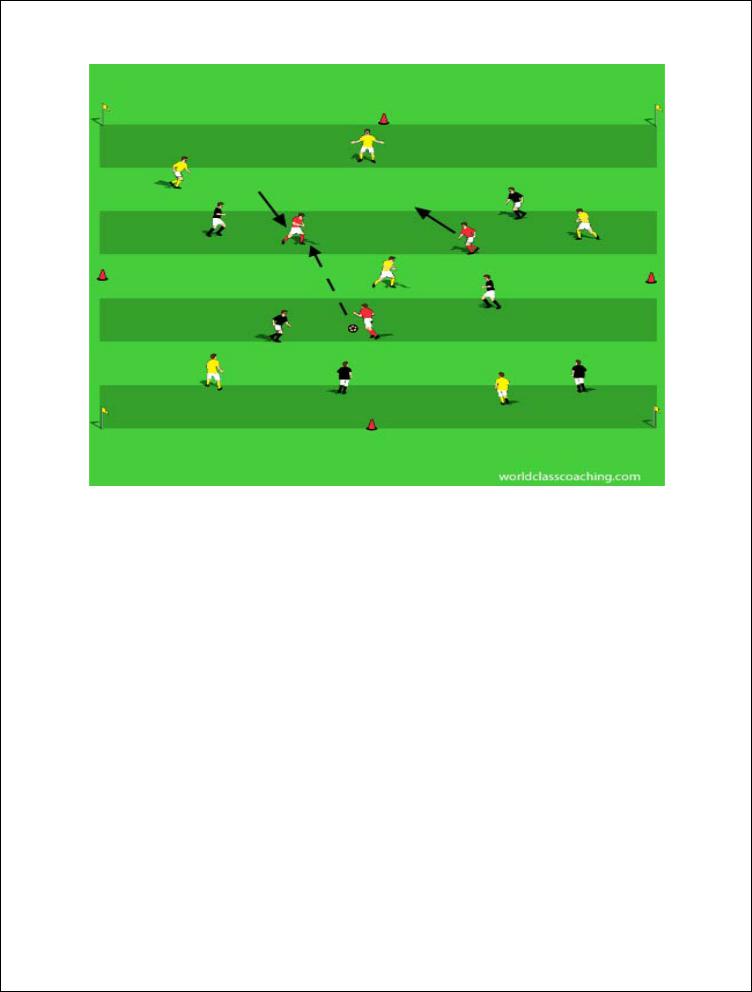
6 vs. 6 vs. 3 40x40 yard grid Create two teams of 6 and a third team of central midfielders (3). This is a pure possession exercise wherein the entire group works on possessing the ball numbers-down, and the central midfielders in particular have to find each other under tremendous pressure. The two teams of 6 earn a point for every 4 passes connected and the group of three get a point for each pass they connect. This exercise is useful for the triangle members in that they must constantly coordinate against heavy odds to both win the ball and also to keep the ball once it’s won. Interestingly, the frequent result of this game is that the triangle members outwork everyone else and win the game going away, giving the coach the opportunity to reinforce the value and necessity of high work rates all over the field and particularly in the triangle midfield.
Coach:
•triangle members must have tremendous awareness and be able to think ahead. Attacking or defending on an individual basis is futile in this setting and triangle members must constantly have their heads ‘on a swivel’ to detect pressure, find support and cordon the ball defensively.
•communication. Relatedly, the triangle members must provide constant feedback to one-another as an additional means of controlling and directing the game.
•triangle members should think about how to be successful on both sides of the ball. They will not be able to win much of the ball against such odds by simply running around, but two (or three) of them may find opportunities to isolate and win the ball through coordination.
•transition. The triangle is the engine of the team and it is frequently the scene of transition one way and then the other in the game. Triangle members must learn to maintain a jogging pace with play and then be able to ramp up for frequent, short sprints in transition, and they must constantly remain mentally in tune with the game. There are very few breaks for the triangle members.
©WORLD CLASS COACHING |
Page | 68 |
FC Barcelona – Style and Domination |
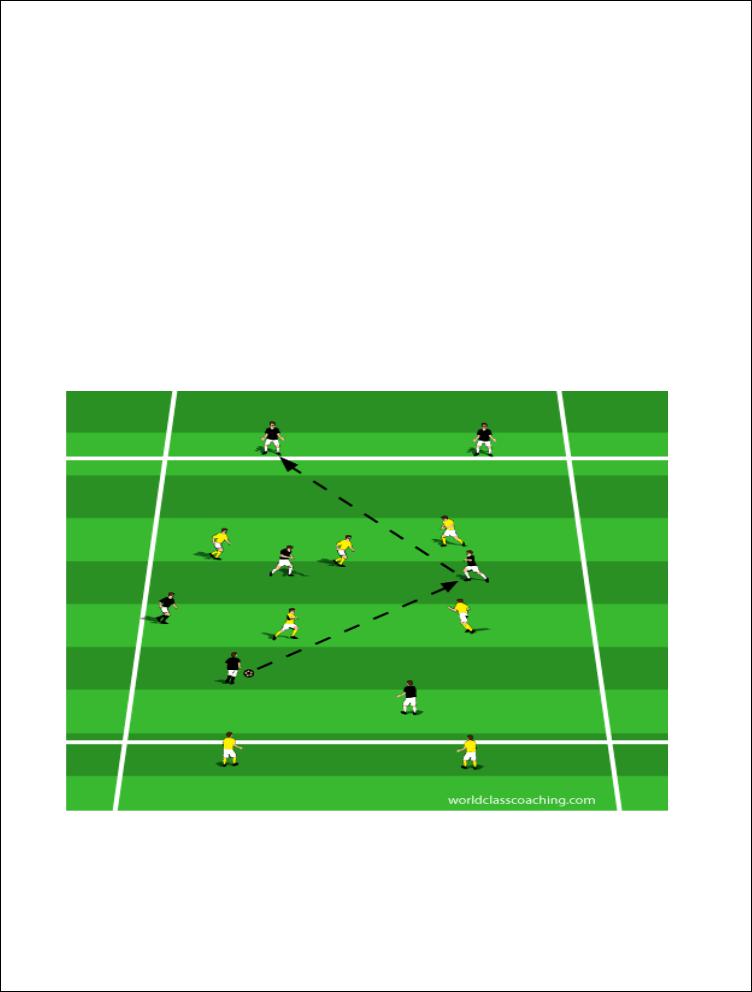
•movement off of the ball. The triangle members must learn to read that when one of their teammates wins the ball and is under pressure, another player must move to the ball immediately in support. If at any time they find space, dribbling the ball and/or wider spacing and or longer passes are desirable to imbalance the opposing teams.
Variations:
•all play is with the off foot.
•no verbal communication. This may seem counter-intuitive, but in short stints it is a useful means of both making players appreciate the importance of verbal communication and also forcing them to do more assessing with their eyes.
•award points for combination play. Give the triangle members extra points for combinations (i.e. 3 per combination).
•attackers are encouraged to play through their central players. Award an extra pass for each touch by a central player.
•to encourage central players to find one-another under pressure, reward an extra pass point when one central player plays another.
End line targets 30x30 yard area Create two equal teams. Each team places two targets on their opponents’ end line. The coach has a ball supply for re-starts. Teams attempt to play in to either of their targets. The person playing in to the target sprints to take their place and the target receiving the ball plays to a back from the opposing team and play continues. Explain to players that this game will only be played for a few minutes (recommend 8-10), so the pace must be very high throughout.
©WORLD CLASS COACHING Page | 69 FC Barcelona – Style and Domination
